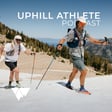Become a Creator today!Start creating today - Share your story with the world!
Start for free
00:00:00
00:00:01

Training for Altitude: Acclimatization Strategies, Part 2: High and Extreme Altitude
In the second episode of our Acclimatization Strategies, Martin and Alyssa discuss high and extreme altitude acclimatization protocols. They break down different approaches for mountains like Denali and Everest and what it takes to prepare for the extreme altitudes. They discuss the various protocols from the traditional acclimatization of spending weeks to a month of moving up and down the mountain to different altitude camps, to using hypobaric hypoxic and normobaric hypoxic chambers. If you’ve been looking to take your mountain activities to the next level, you won’t want to miss this episode.
Check out more information here: https://uphillathlete.com/mountaineering-training/
Or write to us at coach@uphillathlete.com
Transcript
Introduction and Acclimatization Overview
00:00:11
Speaker
Hi, everyone. Welcome to the uphill athlete podcast. I am here with Martin Zor for part two of talking about acclimatization strategies for high and extreme altitudes. So Martin, thanks for coming on part two. Hi, Alyssa. Yeah, I'm glad that we can finish this one and talk about the higher levels of altitude this time. Yeah, I feel like that's the when people think about altitude, they really start thinking about
00:00:41
Speaker
these areas and it gets pretty exciting and a little bit daunting, I think, for a lot of people to know how to handle the really higher elevations that we're gaining. So I'd love for you to touch on what more traditional acclimatization strategies have been and kind of the essentially history of what we've done in the past and where we are now.
Why is Acclimatization Necessary?
00:01:10
Speaker
Yeah.
00:01:11
Speaker
Yeah, that makes sense. I think you mentioned for those that the listeners that haven't maybe listened to all the podcasts before we spoke about altitude physiology and then some of the strategies that are more applicable for lower moderate altitude like last time. But also why do we need these strategies right to start with?
00:01:35
Speaker
like how the altitude affects our body and our physiology and why is it important right so maybe back to the basic why do we need to acclimatize is first first of all really to
00:01:51
Speaker
avoid any sickness. So that is, of course, the one very important point because the higher we go, the more the body struggles to get the oxygen in because with the lower barometric pressure, it's really hard and harder for our lungs, for our body to extract the oxygen molecules from the air to our
00:02:17
Speaker
to the
Body's Adaptations to Altitude
00:02:18
Speaker
blood. That is the main challenge. Of course, the body is trying to adapt to it acutely. Since it senses the hypoxia, there are first adaptations, the increased heart rate, the hyperventilation, and then the whole cascade of adaptations that eventually actually
00:02:39
Speaker
level off and allow our body to somehow function at that altitude. But it comes sort of at a price and if you kind of push through that process too fast, if you go up to higher altitudes too fast without giving the body sufficient time to adapt.
00:03:02
Speaker
then it can definitely backfire and you can, you can, you already feel some effects already on your performance, of course, but then things like headache, dizziness, nausea, vomiting, and then actually more severe symptoms like acute mountain sickness is the first one that actually is actually the sickness. And then more severe are the habe and haste, which are the high altitude.
00:03:31
Speaker
cerebral and pulmonary edema and those are very serious and potentially legal conditions. So we definitely want to avoid that. That's actually the first right. And that can really happen and often happens for people who don't know.
00:03:49
Speaker
Um, and I will talk about that actually with feed people, athletes that actually, they like to push themselves. That might be actually the factor where it's like, oh, I'm just, I'm, I'll be fine. I'm sure I'll be fine. I know how to push myself. My body will handle it. And so, you know, that so happens that they just push and all of a sudden you run into trouble and you start to feel these adverse effects. So, um, yeah, I think for everybody, it's good to just know what is happening up there.
00:04:19
Speaker
and what to expect. But then what are the traditional acclimatization strategies usually to take it progressively to do sort of greatest ascent to higher levels. Now we then talk actually about the high and extreme altitude. So compared to the last time, the last podcast we spoke about that moderate altitude may be maximum four or five thousand meters.
00:04:47
Speaker
But here we actually are talking about the higher mountains, like the Great Ranges, the Karakurum, Hemayas, but also Denali, to some extent Rainier, but I think it's maybe kind of that borderline.
00:05:03
Speaker
Yeah, maybe a Concagua and these mountains like above five, six thousand meters. That's really considerable. And we need to really make sure that the body has enough time to actually acclimatize. It's really that kind of altitude that will affect our performance a lot.
00:05:20
Speaker
And so, I mean, people have been climbing these mountains for, well, many decades now, but even maybe a century when people actually started to go there for some kind
Historical Acclimatization Strategies
00:05:33
Speaker
of research. Or I know that there is a history here in Chamonix where I live, these explorers and researchers, because before Chamonix, it was just pastures and glaciers were all the way down the valley. It was super wild, but nobody really was going
00:05:49
Speaker
Up to the mountains because well why would you and but now tourism and and other other
00:05:58
Speaker
I guess the tourism or mountaineering really is the main reason why actually millions of people potentially go to these altitudes. And so naturally people noticed the adverse effects of altitude on the body, on the health, on the performance. And they noticed, okay, you really need to slow things down. You need to slow down the pace. You need to slow down your progression on the mountain.
00:06:24
Speaker
And so that's actually where we talk about the first strategy really to do the slow and graded ascent. And the kind of common rule that is kind of taken for granted these days is about 500 meters elevation gain per day. What is it in feet? Maybe that's good to know. Yeah. So that would be, it's about 3000 feet. Maybe 1600?
00:06:54
Speaker
Uh, no, or I'm sorry. Yes. 300 meters is about totally up. 300 meters is about 1200 feet. So we're probably talking about, um, I think 1600, 2000, maybe a little bit more than 1600, maybe like 1800. Yeah. Yeah. Yeah.
00:07:15
Speaker
Yeah, well, I think it's really usually when you go up those valleys, like, for example, Kumbu Valley, where many people are now going to Everest Base Camp and, well, that's really now the season. So you are going from Lugla, where is the airport, you land there, and then you start walking up this long valley and naturally,
00:07:35
Speaker
that are sent to the incline of the trails and the way the valley goes you are naturally doing like 10-15 km and about that elevation gain and naturally then you stop in the village and the guides they will
00:07:53
Speaker
guide you there. They will not push you further because, of course, you can go all the way to Namsa Bazaar, which is then the main village up there. But that's more than 2,000 meters elevation gain. So that for most people already, most likely would bring some effects, some bad symptoms, bad sleep and headache.
00:08:15
Speaker
stuff like that so you really want to avoid that and just take it day by day and gradually gaining that altitude but possibly then because your body is of course going through that process of acclimatization and we talked about this before it's quite a stressful process it brings a lot of oxidative stress as well in general to be at that altitude
00:08:38
Speaker
there is more of the oxidative stress than usual. And so it's really good to take that into account and take it easy, take an extra rest day. So usually every two or three days, you actually stay at that one place and take it easier.
00:08:55
Speaker
Or you just reach that bigger village like Namche Bazaar, for example, and you stay there for one day, one night extra. And then you just do the daily hike above. Usually people go to that Everest Hotel view, which is actually the first point you see Everest from there. So, and other mountains, of course, Amadablam and others. But yeah, that's actually the first moment you see Everest. It's quite emotional.
00:09:20
Speaker
Can be but then you just come down back to the village and you sleep an extra night in that lower altitude so I guess that's that's really what what this the basic strategy is and then eventually if you we talk about Everest
00:09:38
Speaker
So the Everest Base Camp is 5,300 meters, at least on the south side in Nepal. And so people usually take 10, 12 days to actually get there. And so on the way, they maybe go to these acclimatization hikes. So again, they reach a village.
00:09:56
Speaker
You can always do like a 500 meter elevation gain hike above it there are so many trails around so that's usually the strategy and you just kind of walk around the trails there is a lot of tracking options there.
00:10:12
Speaker
And you really are gaining more and more altitude. So starting at Lukla in Lukla, which is 2,300, I believe, 2,300 meters. So you are really then moving to 3,000, 4,000 meters. And so most of the valleys are at that level and you are just gaining more and more.
00:10:31
Speaker
of that acclimatization, all those adaptations, increased hematocrite, which as we talked before, takes days and weeks and it actually keeps increasing. And so by the time you reach to a base camp, as I said, it is around 5,300 meters altitude. So by the time you should be acclimatized to that level. And then, of course,
00:10:58
Speaker
That's the first stage that's really the first ten days two weeks and then you're okay to this if you really speed it up and you were straight you went straight to this level.
Planning for Expeditions and Acclimatization Timelines
00:11:10
Speaker
Most people would get sick or some people actually even died when they tried to i heard about is actually. About people who just ran up there in one or two days without a climate ising at all and.
00:11:27
Speaker
Yeah, went badly. They just died in their sleep or something. The body just didn't do it. So it can definitely happen. And so that's why it's really important.
00:11:37
Speaker
to take it slowly. I think what I would like to say, it might be actually possible to get there faster, but again, the back to the timeline of adaptations, the whole cascade of adaptations that happen in the body, what is important to understand, and maybe just remember, they take days and weeks and months, some of them. So it just really needs to embody the time and just follow along.
00:12:07
Speaker
And once you get there, then yeah, that's next stage actually to of course acclimatize to the higher levels on the mountain. Gotcha. So what for traditional strategies say we'll do the, what does it look like time wise for Denali, Aqua and Kogwa and then 7,000 meters and higher and then 8,000 meters and higher. What are those time, what's that time look like?
00:12:35
Speaker
Well, it's kind of naturally evolved actually that the expedition companies even offer the trips for a given time. And I think it's actually just the least amount of time that is sort of healthy, I think, because everybody would just get there, get it done and go home.
00:12:57
Speaker
But as I mentioned last time, we talked about Mont Blanc, for example, that, you know, people actually come here and some of the companies or guides, they take you up there in four or five days, some of them even in shorter time. And that's, you know, just really, really playing it not very carefully. But it may be that one extra day, like first one or two days, you just go to 3,500 meters to acclimatize.
00:13:26
Speaker
quickly but it's really just that first one day or two and that will allow you to not actually get sick so it's really that first first point discovered not to get sick and just get to the summit but of course you cannot expect miracles your performance will be average you might actually feel not so great if you sleep in the hut you or your sleep who might be really bad so I would definitely recommend to come to Chamonix and just spend here at least one week
00:13:54
Speaker
and really to climb some lower mountain and acclimatize. So when we then talk about a higher mountain, like a Kunkagwa, so...
00:14:03
Speaker
When I was there a couple of years ago, I was there almost 20 days and that was quite enough time to acclimatize logically. But also, I wish I could actually stay there longer because also for that performance, I knew that I was still acclimatizing. But let's say for Akoncagua, most companies, I think, aim for about two weeks, sometimes three weeks. But the permit for the mountain when you enter the national park on Akoncagua,
00:14:33
Speaker
And then you leave the park so you have 20 days. I think that hasn't changed since I was there last time so that you can be there 20 days. So also logically they must know that that's enough for this almost 7,000 meter mountain for people to be acclimatized. But yeah, just knowing that some companies will try to make you summit and
00:14:56
Speaker
maybe 10 days to 12 days. The Kakum Kagwa definitely is known for bad weather. It can be super windy, so you need to wait for the summit window, especially with the wind and windshield, the cold, or sometimes even snow, of course. But then if you really are running out of time, then you have to just throw all these acclimatization strategies that are ideal.
00:15:21
Speaker
just throw them out of the window and then you just go for it even though you know that you're really still not exactly acclimatized. But the strategy up there is really similar to what I just talked about with Everest Basecamp. So you arrive to about 3,000 meters by car and then you start walking, tracking up the valley.
00:15:45
Speaker
and you really gain maximum 600-700 meters to the first camp. The next day people usually stay there actually to sleep and then you walk, do this trekking, trip over to the south side and back on come back to the camp and stay there. I think it's about 3000
00:16:04
Speaker
maybe 700 meters, I don't remember exactly. But you're still staying in that safer zone and spending an extra day. And then day three, you are walking towards the base camp, which is 4300 on the
00:16:19
Speaker
on the blood side and the mola side and so naturally you're just gaining gradually that that altitude again as we talked about that's the ideal situation and from there you usually take an extra rest day and from there you do the rotations
00:16:34
Speaker
Come back to the base camp and that's already like day six day seven so that my week is done naturally and then you actually start going up the mountain and usually the the companies don't mess around they actually start started the
00:16:50
Speaker
the ascent up the mountain, camp to camp, and they try to summit. So it really goes quickly. I think it's usually it's really quite a fast ascent. So for my clients who are preparing for a Konkagawa, in this case, specific mountain, because it is a tough one. It is a big mountain. It doesn't feel like it. Technically, it's not difficult, but
00:17:19
Speaker
It is really high altitude and so I tried to prepare the clients for that so you actually are pre acclimatizing right so you actually are trying to spend some time in the real altitude or the simulated which we will talk about later.
00:17:36
Speaker
Denali, usually the companies or people go there for three weeks. Denali is in the fountain, so you will really want to be ready physically. That's a whole different level of how to prepare, but I think there were other podcasts talking about specifically Denali, what it takes, what factors are really the determinants of your performance there.
00:18:01
Speaker
But let's talk about the altitude. So you are landing on that glacier first and that's not really high, very high. I think it's about 2-3,000 meters and then you gradually go up. But the physical effort there is very important. So you need to really be ready for that.
00:18:18
Speaker
you are pushing yourself way hard you're carrying your weight i mean your weight in like the backpack everything all your equipment you usually are carrying yourself and putting it on in the slot so it's a huge physical effort and actually then you're doing that uh graded assent to the higher camps but usually you have quite a lot a lot of time to acclimatize but still the combination of everything the weather
00:18:46
Speaker
the colds the conditions there you want to really make sure that you're ready but i think most of the companies manage this quite well with the timing for to acclimatize so that is just good to know that now that the time frame is about two three weeks so that should be enough again as we talked about it before
Fitness and Training for High Altitude
00:19:09
Speaker
altitude, as it's a function of the barometric pressure, the further you go to the north or to the south on Earth, the barometric pressure changes. It's related to the temperature of the air, so the colder it gets.
00:19:30
Speaker
The lower the pressure, the hotter it gets, the gas molecules are denser with heat. We all observed that mountains, for example, equator,
00:19:46
Speaker
close to equator, the altitude doesn't feel the same like Denali. Denali is really far up north and it's very cold. Even if it's only 6200 meters, it definitely feels like a 7000 at least. It's quite good to be aware of that on these mountains.
00:20:10
Speaker
When we then talk about higher mountains, so anything higher than a Konkagawa is in Asia. So a Konkagawa is the highest mountain outside of Asia. So all the 7,000 meter peaks and 8,000 meter peaks are either in Pakistan in Karakurum or Himalayas, and then some of them also in Kyrgyzstan and those countries. So Pamir, I think there are five of them, just know that
00:20:39
Speaker
Of course, now we talk about the extreme altitude. Anything above 7,000 meters is very serious, and so we definitely need to spend more time to be acclimatizing to those levels. I would say at least three weeks, but if not more, because all the traveling, usually the mountains are quite remote, so it takes a while to get there. Then you get there maybe after one week leaving your home.
00:21:04
Speaker
And then you're actually only at the base camp. So then you really need to acclimatize. Usually it's quite a dramatic elevation gain from the base camp, from the valley floor to the top. You got to 3,000 meters, sometimes even more, on some of the mountains. And so you can imagine then the ascent will take a long time.
00:21:27
Speaker
And more and higher and higher you go, the effect on your performance will be more serious. And so you just need to invest more time. So normal ascent of Everest, for example, even with supplemental oxygen takes at least six weeks, but usually it's seven or eight weeks. It's not a short commitment. You've got to be willing to put in the time, plus all of the training before that. So yeah.
00:21:56
Speaker
I think it's good to be realistic on that regard. Definitely. In Appellate, we have our clients athletes who are aiming for these mountains, so we naturally talk to them about this.
00:22:13
Speaker
So I think it's also worth mentioning how far away from the actual climb should you start with training, right? So it actually also is a function of that. The higher the mountain, the more serious it is, the bigger the factor of fitness is. So, you know, it definitely is definitely worth starting to work properly and really start to understand how your body works and then
00:22:43
Speaker
because all that fitness will go down with altitude. That's the tricky part, right? So you definitely want to arrive to the mountain as fit as possible because that capacity or Arabic capacity and the whole fitness will be cut down. And so it's really definitely worth to prepare as much as you can.
00:23:13
Speaker
Absolutely. Yeah. I mean, I think I can probably speak for most coaches when it is very relieving when you have a client that says, Hey, I have a long-term goal of climbing Everest in a couple of years versus, Hey, I want to do it in six months. It's just a, a more realistic timeline also shows there's a deep level of dedication to thinking long-term versus the more immediate gratification of a shorter time, time zone.
00:23:44
Speaker
Yes, definitely. I think it's quite a big educational aspect of this job that we try to do here. And it's also the part I actually like a lot, you know, just try to show the people, show the clients, my athletes, what it takes and actually pick some different mountains to actually build up that level. One, the physical preparation.
00:24:10
Speaker
But also, of course, mountaineering is a sport where the technical aspect is super important, the skills and all that management gear, knowing yourself and just really being able to deal with the conditions. And so, yeah, it's it's multifactorial. And so it definitely helps if we have enough time to build it. Yeah. Right. Yeah.
00:24:40
Speaker
No, there's so many pieces to it. But one of those pieces, which I think is a great place to touch on, is cardiorespiratory fitness for high-altitude mountaineers. And can you get into what, like, an upper-level athlete, we don't talk a ton about VO2 max, we tend to focus a little bit more on lactate levels, but in this case, VO2 max is a really interesting way of measuring
00:25:10
Speaker
our fitness and also altitude has a significant effect on VO2 max. So love to hear more about that from you.
00:25:20
Speaker
Yeah, that's exactly. I think we mostly try to maybe emphasize the importance of the submaximal performance, right? So mostly that zone two, and then maybe some of the higher intensity, but what is most important for most people, of course, it's individual, right?
00:25:43
Speaker
We deal with each athlete individually, but what you really need to have is the large Arabic capacity. But the VOMax really, what is that, is the maximum Arabic capacity. So how much oxygen can you actually get through your body, distribute and utilize, right? So it's the maximum. It's actually defining your kind of the cap, the top of your Arabic fitness.
00:26:08
Speaker
And so, of course, we will never be very likely that we will not be doing that on the mountain or you will not be reaching that level or the intensity. But, of course, you will always be at that fractional utilization, which is more or less the lactate threshold or below or some percentage of it, right?
00:26:32
Speaker
So I think in that sense, it's useful to know what your VO max actually is, first of all, but compared to other endurance sports, it's less of a factor that's, I think, where we come coming from within uphill athlete.
00:26:47
Speaker
So, because like running in endurance sports, running, cycling, in low altitude, of course, the science saying that the main determinants of performance are the VOMACs, diffraction utilization, which is the lucky threshold, and the running economy or cycling economy.
00:27:10
Speaker
But here, let's talk about it. What actually happens then at high altitude? So that's where research has been. The researchers, scientists, they have been actually testing it for as well since the beginning, since actually the climbers went up there and just really trying to find out what was going on. And so I think that there are some fun points just to realize what actually happens.
00:27:35
Speaker
because I already spoke about the Arabic performance generally going down, generally actually for all people it just going down, it hits you, right? So again, back to the barometric pressure is decreasing, what does the effect is actually the density of the molecules of the air of and for one the oxygen that is the one we need and so all of a sudden when you're at 5,000 meters for example, so if I'm
00:28:03
Speaker
Not mistaken here, it's about 60% of the barometric pressure. It doesn't exactly correlate to that you're on 60% of your Arabic capacity, but I think you can imagine that it's pretty close that you're almost on at half, right?
00:28:19
Speaker
when you stand on Everest without utilizing the supplemental oxygen that of course affects everything but without oxygen you're on 30% of barometric pressure compared to sea level so imagine then if that affects your Arabic capacity by that largely which actually doesn't exactly work that way so you can imagine that you definitely want to have your
00:28:44
Speaker
Arabic capacity as high as you can because you are you will be at a very You will be working at a very small rate of it the higher you go, right? So it's in your best interest to to have the best possible Arabic capacity and the maximum is the BO max. So it has been
00:29:08
Speaker
In the science, there are some interesting numbers that when we go above 1,500 meters, our real max decreases about 2%, 2%, 3% every 300 meters of the additional increase. So it's going down real fast if you start counting, right? And then some other interesting numbers that if we are in 5,000 meter level,
00:29:38
Speaker
So then we talk about the maximum uphill rate speed. So for me, I'm really working in that level. So when I'm trail running, when I'm doing my training workouts in the mountains here around Chamonix or on the mountains, I don't really measure my speed on my watch by minutes per kilometer or minutes per miles, I guess, because that's usually what you do when you're running on the flat. That's the metric to go for, right?
00:30:07
Speaker
but in the mountains that doesn't really make much sense so it's really good to know when you're in the mountains what elevation gain you are doing per hour that's usually the metric you can actually choose on your watch it's super helpful for me so i know that if i'm going at
00:30:23
Speaker
thousand meters per hour that's sort of my zone two more or less depends really of course the higher I go then actually goes down right so when I'm doing my my races uphill races vertical races then of course this number goes up but it's really good for me to know super super useful number but then when I was now in Nepal for example and I was running at that altitude around five thousand meters
00:30:48
Speaker
then you can really see how is that changing, right? If I was at 800, I was happy, and I could see that if I push 2000, which is normal speed for me here in Chamonix, which is 1000, 2000 meters down in the valley, well, definitely doesn't feel the same at that high altitude. So it's just good to know that for most people,
00:31:13
Speaker
when you're hiking with your backpack of course you have some weight of your gear so usually people are hiking around three hundred five hundred meters of elevation gain per hour and that actually you can measure in the lab that this requires some oxygen like oxygen utilization the metabolic cost of that exercise right so actually based on that the researchers said that
00:31:42
Speaker
The VOMAX around 50 milliliters is actually per minute per kilo is actually what is required to be able to do that speed at 5,000 meters. So that's actually giving you some idea because you can actually go to the lab. You need to go to the lab actually. That's the only way to have a precise assessment of your maximum aerobic capacity, the VOMAX.
00:32:06
Speaker
So maybe that's actually something that people can do and just to see, okay, I'm at 40. So that probably will be fine for 5,000 meters. But if I want to climb at 5,000, 6,000, and I still want to do a solid speed, then I will need to do something about it. And so that's where the training comes in. And you can definitely improve the VioMax by training, right? Yeah, absolutely. I am curious.
00:32:35
Speaker
So say because 1500 meters is not that high.
Training at Altitude: VO2 Max and Performance
00:32:40
Speaker
Are there labs that are at or above 1500 meters that people are being tested at? And how do they account for the decline? Do you just say hey, add 1% to this because we're at 1700 meters? Or do you know much about that?
00:32:59
Speaker
I think that's a good question. I don't really know, but I think at least in my area here, I know that the lab close to Chamonix is down in the valley actually, and it's at 700 meters. The bottom of the valley, the city actually is in 1,000 meters altitude, and it might have a bit of effect, I guess, based on what we just talked about. But I think it's really only just a couple of... The number will be very low.
00:33:28
Speaker
And so I think logically, the universities, that's where usually the labs are with the Sports Science Center or the Performance Lab, you know, they need to account for this because as we talked about it in the last podcast, the 1500 meters actually really marks maybe the 1800 meters kind of marks that level where
00:33:50
Speaker
you are actually going for a training camp for an altitude camp, right? To get those additional gains, usually going really for the increased hemoglobin and actually pushing your VOMAX by that. You're actually increasing your oxygen carrying capacity of your blood. So that actually increases the VOMAX. So in that sense, I think those test centers would tell you, you know, logically speaking.
00:34:18
Speaker
But I guess in the States might be different. Some of the cities where the universities are, they are actually at these altitudes. Kind of about that. Yeah. It might be tricky. But then I will tell you definitely. Yeah, I would be curious, especially in Colorado. I mean, one of where Chantal, our director of coaching, went is quite a bit over 1500 meters. So we'll have to check in with her about what they accounted for on that.
00:34:47
Speaker
But yeah, I'm sure there's a formula somewhere. Yeah, any last pieces you want to touch on with improving VO two max and how that can boost
00:35:02
Speaker
So again, I don't want people to think that the VOMax is something that you absolutely need to improve. Of course you want to, but again, there is a whole lot about training, right? So you definitely want to spend the most of your time, as most endurance athletes do anyway, with so-called polarized training. I mean, maybe, of course, that can change.
00:35:26
Speaker
with different scenarios, but polarized training means that you really are spending most of your time in the lower zones. Let's say low moderate zones of intensity really are trying to work on your Arabic endurance and that's definitely submaximal. That also improves your VO max, but actually then there are specific ways to improve that VO
00:35:50
Speaker
max top of your Arabic capacity by doing high intensity work. But I don't want people definitely not saying that it's the only way, that's the only thing you should do. That would be wrong and you would, yeah, that would be a bad plan.
00:36:07
Speaker
But I think it's good to touch on that and just to have some numbers there in your mind. What actually does it take? For example, for Everest climb, which is the highest mountain, what does it take to climb it without oxygen? We mentioned this before, but I think until this time or until today, it's about 8,000 people who climbed it.
00:36:36
Speaker
but most of them climbed it with supplemental oxygen which really kind of brings you down to maybe 1500 maybe 2000 meters slower right so the air the the oxygen you're breathing actually brings you lower and that's what allows most of these people to actually climb that mountain without supplemental oxygen is quite a different beast or actually entirely so only 200 around 200 people have succeeded the
00:37:03
Speaker
It's a big undertaking and very risky, but it takes a lot of physical capacity. But again, I think what is important maybe just to put a conclusion there is VioMax is really just one part of it.
00:37:21
Speaker
I think it was just good to mention and talk about it a bit. In general, you really want to be as fit as possible when you go for these mountains and for that high altitude. But then let's talk more about that acclimatization and what's going on and which adaptations you need to actually survive and be able to function and then go fast.
00:37:43
Speaker
Right. Because if you are not fit, if the people are not fit, then go up there. So again, that uphill speed gives you pretty good idea where you are. So if you are at low altitude and you are not even making maybe 300 meters per hour of elevation gain on some steeper hike, on some steep incline, right? So, you know, that it will take you quite a long time to actually go from point A, point B to the next village or from camp to camp. So imagine what it will take you at 6,000 meters, for example.
00:38:13
Speaker
then you're just too long and it will be dangerous and it will actually probably be impossible. The way the body reacts to that altitude and how that altitude affects your performance is so big, so important, then you really need to make sure that you are faster and faster to be safe and to actually make it to the top. Yes, no, it's so
00:38:38
Speaker
I mean, when we are talking about, we're not just talking about, Hey, I finished the race faster. We're talking about very direct living or dying in extreme situations. So yeah, it's, it's crucial when we're really getting into these much, much higher altitudes.
00:38:56
Speaker
All right, so that leads us perfectly into one of the main topics of the conversation today, which is use and effects of intermittent exposure to altitude. So Martin, can you take us into this? Yes.
00:39:13
Speaker
Now that we know what time it takes to acclimatize for these big mountains, then we can actually create a strategy where we acclimatize. Usually, these big mountains take so much time. You have to really spend so much time over there that you might just want to try to acclimatize before, if you can, if you have that opportunity, so that you don't need to spend weeks and weeks and meet sometimes
00:39:41
Speaker
months in those mountains. So for most people, this is, of course, a big deal because you're just away from your business, from your life, from your family, etc. So differently, there are strategies to go around it. So I guess there are two options to
00:40:00
Speaker
Two options where either you live close to the mountains so we actually have that real altitude available so then we actually talk about the intermittent exposures to altitude in most cases because you're not really spending all your time in hypoxia in altitude but what actually matters is the hypoxia right.
00:40:19
Speaker
the hypoxia y is that that's what the body senses the body doesn't sense altitude as such it's actually the hypoxia so the reduced amount of oxygen that you're breathing and and the body senses it there is less of oxygen in the blood and that's where actually the reaction and the cascades of cascade of those adaptations starts to happen
00:40:41
Speaker
But then imagine you go to the mountains for the weekend, or even for a couple of hours, you take the lift up to here in Chamonix, you go up to Ego de Midi, which is 3,800 meters, and you ski up there. But in two, three, four hours later, you're back down in 1,000 meters elevation. And as we talked about it, that's not really significant enough to bring any of these adaptations.
00:41:04
Speaker
So, then we are actually really talking about the intermittent hypoxia. So, can that work? Is that enough? Well, that's a huge chapter to talk about and we cannot really cover it here. So, I just want to know people to understand that yes, to some extent you will be acclimatized if you live here for a season or you just live here for long term or places in Colorado, I guess, where you are actually living already at significant altitude actually.
00:41:33
Speaker
Is that enough or how much do you need that? Will that be enough when you are planning to go to a ConCago one?
00:41:42
Speaker
So for example, I had clients that were going to Akonkagawa this last season in January, February. And so we actually planned for some extended weekends or one week actually, they went to places in Colorado where they were actually in the hotel in 3000 meters. So that was actually a real altitude exposure. Also being able to combine it with really good physical training, right? You all of a sudden have great options going for the
00:42:09
Speaker
uphill hikes, et cetera. So combined, it's a great kind of benefit, combined benefit to actually spend time in the real altitude pre-acclimate test. But again, there are some costs too, of course, it costs you money, but that's where the strategy comes in. So we talked about it extensively and say, okay, this will be the best strategy because the athlete is really worried about how he's going to respond or she's going to respond to altitude.
00:42:39
Speaker
Yeah, it really is different scenario. Some of my clients, they live at altitude and at close to 3,000 meters. So for them, it's a huge advantage, of course. So that's one kind of chapter where you really want to consider what are your options, how much is it going to cost you, and also is that enough? Actually, is it actually enough?
Pre-Acclimatization Techniques and Research
00:43:03
Speaker
of that altitude exposure for you to to to acclimatize and acclimatize enough then that when you fly to the mountains then to the big big mountains and to the foreign country what can you actually expect are you to what level are you acclimatized already then there is a second chapter which is the normal very one so maybe we can discuss about that
00:43:27
Speaker
Yeah, let's get into what are the different types of simulated altitude that someone who doesn't have access to getting these mountains or at least needs to supplement. What are their options?
00:43:41
Speaker
Yeah, I think that actually most people, they don't live in the mountains, right? The most big cities, they are close to ocean, not really the mountains and around the world. But it doesn't mean that you don't want to go and climb the big mountains. So what can we do about it? Of course, the best option is, again, to go to the mountains and just maybe move to a mountainous area, but it's not always possible, of course.
00:44:07
Speaker
So actually, there are nowadays so-called normal baric hypoxia generators. Why normal baric? So when we talk about hypobaric, hypo means in general something lower, right? So baric is actually the pressure, in this case, the atmospheric pressure. So hypobaric hypoxia is actually the hypoxia caused by the lower atmospheric pressure, which is the case in the mountains.
00:44:34
Speaker
Normal baric is that something is normal, so the pressure stays the same, but the hypoxia is actually created artificially by generators that actually change the ratio of the molecules in the air.
00:44:54
Speaker
Around the air we breathe if we are at sea level or we are at five thousand years or we are actually on the top of ever doesn't matter there is always around twenty one percent of oxygen molecules out of all the molecules of the of the gases different gases.
00:45:10
Speaker
The most prevalent is the nitrogen, that's about 80%. And then there is a very small fraction of the other gases that are not really important right now. What matters is the oxygen. So what these generators are actually doing here, they are actually increasing the ratio of the nitrogen.
00:45:29
Speaker
and reducing then the oxygen. So you're going from 21% to then lower fraction. And I think if I'm not mistaken, around 10% level is about 5 to 1,000 meters. So every percentage of oxygen has corresponding simulated altitude. You're trying to simulate altitude by reducing the oxygen, right? So this has been
00:45:58
Speaker
This has been used for a couple of decades now. So there are also actually chambers that actually are functioning as a kind of training facility or
00:46:13
Speaker
being used for research. Some of them are actually hypobaric, so they actually are reusing the pressure in there and then actually affecting or causing the hypoxia. But that's really rare, actually. That's very expensive and very complicated to make and usually is done for use for research. But what is actually the most used is the normal baric one, so you are then changing really the ratio.
00:46:38
Speaker
of the moleculars and that you can find the facilities now in the gyms, some commercial gyms, they already have that. There are actually different uses for this as well, not only to prepare for high altitude, just saying that you can actually prepare for your trail race or just basically trying to increase the stress of the exercise by, you know, you're in the city at sea level and you just go to the gym and you will run at 2000 meters. So you can expect that there will be some additional effects to it.
00:47:08
Speaker
But now what we can actually, how we can use this in our scenario when we prepare for the big mountains, right? So there are also generators that you can bring home and you connect it to a mask that you put on your face and you breathe this hypoxic air or
00:47:29
Speaker
you have a tent and you put it over your head, it's like small version or it's basically big tent over your bed and the generator is actually changing.
00:47:41
Speaker
the air and you're actually in hypoxia. This is the normal baric hypoxic strategies where we actually can be training at home and of course intermittent hypoxia because you're not staying there all day. That's impossible or that would be pretty extreme. Why is it important to talk about it?
00:48:05
Speaker
in a way that is intermittent is that when you go to the real mountains, you go to the valley, you start at 2,000, 3,000 meters, wherever it gets you to, you get there by plane, by helicopter, or just by car, whatever, and then you start going up that altitude and actually you're staying there. That's the important part.
00:48:26
Speaker
where actually the use of hypoxic tense or the chambers is that you spend some hours in there and then you get out and you're breathing the normal air, of course. So this is the important distinction to realize. And so it still works. We, of course, do this sort of like an interval training. We do hypoxic training and then we work.
00:48:56
Speaker
when the day out and then we go back to it and then of course it's important to know does that work to what extent how long do i need to do this or you know and that's a that's the whole different chapter yeah that's much more specific to the individual the goals of the expedition how high you're going you know there's so many factors that we can't you know say do x y and z and
00:49:22
Speaker
be in it this many hours and such and give you a prescription on a podcast. But that's where people like Martin come into play where you can use him as a resource by hiring him through up athlete. Many of the guiding all pretty much all the guiding companies have some kind of protocol have the means to allow you to pre acclimatize. But I'm curious
00:49:49
Speaker
How has it been shown that hypobaric hypoxia and norobaric hypoxia work? You actually seem to have some pretty cool facts of like, hey, it does work. Yeah, of course. So, you know, usually the research works that you take a group of people, you test them at the base level, so the low altitude, and then you take them.
00:50:14
Speaker
to some, whatever, mountain hut or, yeah, to actually the Everest base camp or...
00:50:24
Speaker
or other places where you can actually really do the study in a comfortable way and really compare the base level and then the high level or you do the protocol or the test, you actually do that in the lab, right? So where you actually are using that normal very hypoxia. But I think it's good to just mention what they have found or there's been so many studies about this.
00:50:52
Speaker
But just to actually see what the effect is. So for example, five days per week of hypoxia for four hours, which was actually hypobaric in this case. So we're not actually talking about that lower atmospheric pressure.
00:51:10
Speaker
But that actually improved the Arabic performance. So actually doing some kind of physical testing, right? You were doing some bike and they were measuring some metrics to actually evaluate your performance. So first day in that hypoxia was really bad. Your performance went down. But after this exposure to the hyperbaric hypoxia, that improved quite significantly by a large number.
00:51:35
Speaker
And then the ama so that's usually the acute mountain sickness you evaluate that you basically have a questionnaire like who's. Question is usually want to use so you basically are taking off the do you have any symptoms right so that's the best evaluation if you're experiencing the mountain sickness so to some degree and so when you actually are.
00:52:03
Speaker
take these people who are not acclimatized to about 3,000 years, but higher it is, of course, than most of them actually will get sick. After this last one week of hyperbaric hypoxia, there was zero, zero of symptoms, right? So it actually shows you that after several days, maybe one week ideally, and longer, the main effect as we talked about it, right, the AMS just disappeared. So it really works.
00:52:32
Speaker
I think the most
00:52:36
Speaker
What people ask more often is actually does that normal baric work compared to the hypovariac one, right? We know that when you spend some time in the real mountains, in the real altitude, you will acclimatize very individually because this is actually something we keep mentioning, that acclimatization process is very individual. And we don't exactly know why the scientists are still trying to really figure that out.
00:53:04
Speaker
What is it? What is it about? It's not only, it's a one factor, but it's not about physical fitness. Definitely to be physically fit, we encourage everybody to do that when you go for the mountains. It's a big factor, but it's not the only one. I've seen it on funny, it was a guilty media. I used to work up there for 12 years.
00:53:24
Speaker
And that's a really nice kind of testing situation. You take people from, they arrive here, they taxi or bus or whatever, and then like, oh, let's go up there. It's amazing. It's going to be amazing view and stuff. And so from 20 minutes, it takes to 3,800 meters. I mean, the amount of puke I've seen in my life over there, it's quite a big question.
00:53:50
Speaker
I can tell you, you have to be careful sometimes, but it's just normal and people faint. They just collapse right there on the spot. You kind of open the door of the lift and then you are at 3,800 meters. Really, it takes you that fast within 20 minutes on a busy day.
00:54:08
Speaker
you go from 1,000 meters to almost 4,000 meters. And also, it was just amazing to see that you got alpinists, like people, sporty, young, and then you have old people. Well, actually, the alpinists, they fainted sometimes.
00:54:25
Speaker
So it's actually where it's helped me realize that physical fitness definitely helps, but it's not the only thing, you know, it's, it's, there are, there are definitely some, many, probably many factors in the body that need to be there. And that's where the individual response to altitude is. And it's good to know it's good to be aware of that. So now we've heard that hypobaric works, which is amazing. How about normobaric?
00:54:55
Speaker
What have they found? Because that's probably on the more, there's more skeptics on that side. Definitely. People definitely have been skeptic and still are, of course, because it's strange. How does that work? How does that machine work? It's sometimes very uncomfortable to use that also. It's not the same. Of course, it's not the same as the real altitude, as that thin air we call when we actually go to the mountains.
00:55:23
Speaker
But there have been many research studies on that, and some of them actually didn't really find much, so there maybe have been some skepticism about that. But nowadays, we can actually confirm that it works to a large extent, and you can actually really use it to pre-acclimate us.
00:55:44
Speaker
We are an uphill athlete working with Fürtenbach Adventures, which is an expedition company leading and guiding people in the big ranges. Right now it's Everest and actually now they are our collaborators. We have been helping them with physical preparation of their clients.
00:56:03
Speaker
And so they are actually using the hypoxic tents to prepare the clients for so-called flash expeditions. So it's actually a situation that I talked about, right? So for example, Everest, you need to be there more or less eight weeks, two months to be on the mountain to acclimatize slowly with that graded ascent all the way to the base camp and then slowly going up the mountain, of course, then
00:56:30
Speaker
It really takes a long time. And so for many people, it's actually not possible. And so using actually that pre acclimatization in the tent where you're actually in your home, you set it up, of course, it's not nothing. You have to still work around it, prepare it and know how to use it.
00:56:49
Speaker
But it's it's a day for them but adventures specifically they have been using it for many years now and with with success they are able to bring their clients to the mountain and help them basically go straight to five thousand meters or base camp level and basically start climbing to the higher level so.
00:57:10
Speaker
But yes, of course, it's a very complex thing, you really need to know how to do that, right? It's, it's, again, the individual approach there is important, as I just talked about. And so you cannot have one, like one approach for any animal for everybody, right? Otherwise, it would be simple. You just follow a simple protocol, and you just send it to everybody the same thing. And
00:57:35
Speaker
That doesn't work like that. No, I don't actually can really like fire and that's where maybe some of the skepticism has been coming from. But but yes, there this is requires quite a specific knowledge. But again, this this is working and
00:57:51
Speaker
So I think it's really fascinating. And yeah, so just saying this as an acclimatization strategy or more like a pre-aclimatization strategy is very important. And I think for some people might be very interesting. Definitely. And within, so you're, you're working on the protocol, what are some of the variables that
00:58:16
Speaker
you are monitoring that people should be aware
Monitoring and Nutrition for Acclimatization
00:58:18
Speaker
of. I think most people already are using usually when you go to the mountains there in Nepal or the great ranges, not only in Nepal, of course. The best is to have that boost ox meter, which is the clip you put on your finger and it measures your heart rate and saturation.
00:58:38
Speaker
That's pretty much the cardiovascular parameters, the basic ones. How is your body responding, reacting to that altitude? Hard rate. We know now that that's one of the first acute adaptations of the body to the way it reacts to altitude, to hypoxia. It goes up, the increased hard rate. You can already see.
00:59:01
Speaker
that your resting heart rate is much higher than it is at the sea level or back at home. Saturation is really how many red blood cells are saturated with oxygen.
00:59:19
Speaker
Usually it's around the ninety eight ninety nine percent sometimes hundred but it's usually in the high nineties the levels of situation at sea level and in the medicine when you are in hospital and you're in some bad situation the doctors they
00:59:37
Speaker
They measure this continuously, it's very important. And if it goes below 85, I think that's the level where they put you on oxygen or, you know, they, it's really kind of important borderline between you being okay and then not so okay. So
00:59:55
Speaker
In in the altitude this is actually happening naturally so already at two three thousand meters you're probably somewhere around ninety five maybe ninety two. And then higher you go you can expect that it will just start dropping down but with that great it's a climate ization.
01:00:13
Speaker
You are actually trying to stay within some healthy range, but knowing also that some kind of hypoxia, which is showing in that lower saturation, is important. The body is actually adapting to it. But that's where also it's good to know, okay, my saturation is 85. I don't think I should go up tomorrow. I should actually stay at this level. Or you have a person that is really struggling and their saturation is 75.
01:00:39
Speaker
And well, logically they are struggling even like being super pale and really kind of not out there completely. So you need to bring them down. It's really good metric to measure always. And I definitely encourage everybody going to high altitude to start testing this. Again, it will be slightly individual, but naturally then, even if you're a acclimatized then,
01:01:02
Speaker
you are actually going for your summit bush on these big mountains so you're sleeping maybe at the highest camps at six thousand sometimes seven thousand meters depends which mountain you know your your situation will not be very high but you are you're already acclimatized you are your body is actually able to
01:01:21
Speaker
to support that desaturation, and so you're able to handle it. You're not feeling great, but you're not getting sick. That's the main difference. So yeah, I think the heart rate, saturation, and then in the process of the acclimatization, whether it's in the mountains or using that hypoxic tent, it's actually really the time, the time spent in hypoxia.
01:01:48
Speaker
right so between those different strategies like going really to you leave for you leave for those mountains and you're up there all the time so you're actually not leaving that mountain so really are spending training and and also living high so those different strategies train high live high
01:02:08
Speaker
So the time is counting, right? But then if you are in the situation when you are going to the mountains Sunday for the weekend, right? So that's actually, as I told you, the time in hypoxia actually matters when you're not in hypoxia. Well, your body will not will, will
01:02:25
Speaker
not be really adapting so much. So you really want to be aware of that. You want to really know, okay, is that enough or not? So that's where you should get in touch because we can help you out. It's not one way to say this. So yeah, this is the important metric. And that also actually is the case with the tense or with the normal baric hypoxia. So you are actually trying to accumulate the time
01:02:53
Speaker
And how much time is that depends? There are many things to talk about that and kind of also keep it safe, of course. So please, please ask someone or get in touch, but or talk to those companies that actually are using these strategies, because they know how to. And there are many details that are really very specific. But yeah, this is really those metrics that are more the most important.
01:03:20
Speaker
That's that's amazing. And I think it's really helpful for people just to know when to ask for help as well of like, hey, let's not let's not just guess on or look at something briefly on the internet and decide that that's going to be how we'll go about this. Any last things you want to touch on before we
01:03:42
Speaker
I guess maybe it's worth mentioning that also nutrition is very important during acclimatization, right? So in order for us to acclimatize what is actually happening in the body, one of those adaptations is the hematological adaptations, right? So increasing the hematocrite, the hemoglobin, the red blood cells, and what is important there is
01:04:06
Speaker
is iron levels and ferritin so it's really good to do some blood work or testing, talk to specialists or coaches that know how to and why and what are the levels that you want because it definitely affects actually your capacity to acclimatize because if you are on low levels and that can definitely happen.
01:04:29
Speaker
already with extensive endurance training or with women athletes definitely there are so many cases where
01:04:37
Speaker
where the iron levels are low. And so if you are actually preparing for a mountain, I would definitely encourage you to do that. Also, to some extent, inflammation in general that can come from different sources, but also has a negative impact on acclimatization processes. So, you know, you see that there's a lot going on, but it's just good to start that work.
01:05:04
Speaker
really way before the expedition to talk to people who now talk to us, talk to our team, and we get you started and we can really tell you, okay, what is the best strategy already and make the plan. That's fantastic. And we do have an episode with Elisa Lieb, who's our nutritionist on staff talking specifically about altitude because there's a lot of considerations that
01:05:31
Speaker
come into play when you are going much higher than usual. So yeah. Well, thank you, Martin, for all of this wisdom. I think we'll have you on a couple more times throughout the series. So thanks for sharing your wisdom today. Thank you. It's been great to talk about mountains again. And yeah, I'm happy to share all this and just feel free to
01:06:01
Speaker
get in touch and there's so much to talk about and maybe just the last point where for athletes that are maybe trying to actually go up fast, there are definitely more and more people who are trying to challenge themselves in altitude and actually extreme altitude.
Future Topics and Closing Remarks
01:06:19
Speaker
When we talk about FKSTs, fastest known time, but also some races, there are more and more of these that are
01:06:26
Speaker
The trail races, stage trail races, like in Nepal, there is many of them now. So you really are actually trying to perform in a higher level. And so that's another, that's another topic we don't have time to discuss today, but, uh, you know, what, what to do then, how to acclimatize and actually prepare your body for, for an excessive effort performance, um, and then level.
01:06:53
Speaker
Yeah, the plan is to touch on that in a future episode. So you're foreshadowing it well. Yeah, that'll be fun. Yeah, it's exciting. I mean, it's pretty incredible that not only are we surviving, but we're trying to excel. So I think that's a pretty amazing topic to cover. Comes with some trials and tribulations though, we'll say, but. Yeah, naturally. We are athletes and we are looking for the challenges.
01:07:23
Speaker
Yeah. Um, anyway, yeah. Yeah. Me too. Well, thank you, Martin. And thank you for listening to the uphill athlete podcast. If you could rate, review, or subscribe on your favorite podcast platform, that helps us help more athletes be safe in the mountains. Thank you for listening. And it's not just one, but a community. We are up athlete.



















